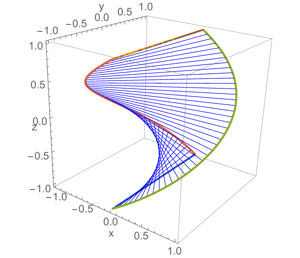A surface is bounded by four lines parametrised as $(x,y,z)=$
$$ (0,u,- 1), (-1<u<1); \, (0,u,1), (-1<u<1); $$
$$(\cos v, \sin v, 2 v/ \pi), (- \pi/2 < v< \pi/2); \, (-\cos v, -\sin v, 2v /\pi), (-\pi/2,< v < \pi/2); \,$$ It is required to find parametrization for constant $K$ surfaces whose
- K= -1
- K= 0
- K= +1
The Dini surface does not meet requirement of a helix border for case 1. Neither Mean curvature H =0 helicoid of varying K satisfies this case 1.
Untwisted constant $ H$ CMC surfaces catenoid, cylinder, sphere of soap films form across two concentric circular tube edges of radius 1 rotated on x-axis.They have respectively their ODE connecting principal curvatures as:
$$ \kappa_1 + \kappa_ 2 = T,$$
where constant surface tension T can take $ -1, 0, +1 $ values.Their twisted surface parametrization is now sought, thanks for your help here.
EDIT 1:
As far as spanning between two helical lines is concerned, I have chosen circular toroidal upper,lower and flat points in the WolframAlpha link in place of Elliptic Integrals/functions as an approximation to the needed situation, K > 0, K = 0, K <0 regions of the torus can be seen.
EDIT2
A helical cuspidal boundary defined by David Brander as a pseudospherical front must have a spherical front' or gorge/groove etc. imho,that at is how one views positive and negative constant curvature surfaces..David Hilbert proved a cuspidal edge boundary and the conoidal point vertex for $K\equiv _1$, and for spherical case $K\equiv =+1$ someone else also proved the same...Am I right?
EDIT3:
Asked in SE Math for a perhaps easier formulation where the limit / boundary of quadrangle patch is removed defining an infinitely long curved strip:
EDIT 4:
If formulation would be more suitable please consider the case of semi-infinite surface formed by removing upper edges and retaining only the helices:
$$(\cos v, \sin v, 2 v/ \pi), (- \pi/2 < v< \pi/2); \, (-\cos v, -\sin v, 2v /\pi), (-\pi/2,< v < \pi/2).$$

